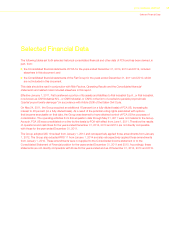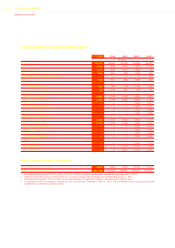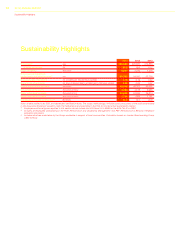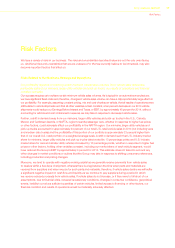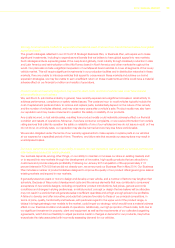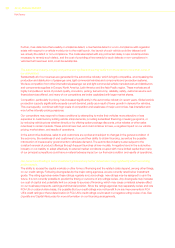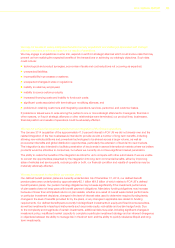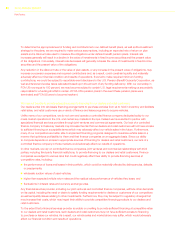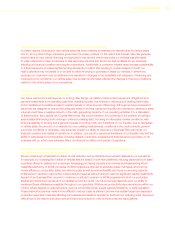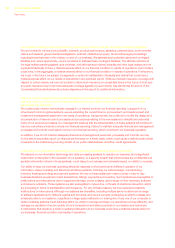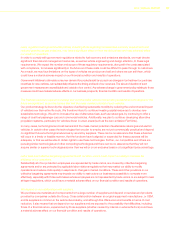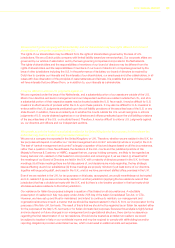Chrysler 2014 Annual Report Download - page 22
Download and view the complete annual report
Please find page 22 of the 2014 Chrysler annual report below. You can navigate through the pages in the report by either clicking on the pages listed below, or by using the keyword search tool below to find specific information within the annual report.
20 2014 | ANNUAL REPORT
Risk Factors
Further, if we determine that a safety or emissions defect, a mechanical defect or a non-compliance with regulation
exists with respect to a vehicle model prior to the retail launch, the launch of such vehicle could be delayed until
we remedy the defect or non-compliance. The costs associated with any protracted delay in new model launches
necessary to remedy such defect, and the cost of providing a free remedy for such defects or non-compliance in
vehicles that have been sold, could be substantial.
The automotive industry is highly competitive and cyclical and we may suffer from those factors more than some of
our competitors.
Substantially all of our revenues are generated in the automotive industry, which is highly competitive, encompassing the
production and distribution of passenger cars, light commercial vehicles and components and production systems.
We face competition from other international passenger car and light commercial vehicle manufacturers and distributors
and components suppliers in Europe, North America, Latin America and the Asia Pacific region. These markets are all
highly competitive in terms of product quality, innovation, pricing, fuel economy, reliability, safety, customer service and
financial services offered, and many of our competitors are better capitalized with larger market shares.
Competition, particularly in pricing, has increased significantly in the automotive industry in recent years. Global vehicle
production capacity significantly exceeds current demand, partly as a result of lower growth in demand for vehicles.
This overcapacity, combined with high levels of competition and weakness of major economies, has intensified and
may further intensify pricing pressures.
Our competitors may respond to these conditions by attempting to make their vehicles more attractive or less
expensive to customers by adding vehicle enhancements, providing subsidized financing or leasing programs, or
by reducing vehicle prices whether directly or by offering option package discounts, price rebates or other sales
incentives in certain markets. These actions have had, and could continue to have, a negative impact on our vehicle
pricing, market share, and results of operations.
In the automotive business, sales to end-customers are cyclical and subject to changes in the general condition of
the economy, the readiness of end-customers to buy and their ability to obtain financing, as well as the possible
introduction of measures by governments to stimulate demand. The automotive industry is also subject to the
constant renewal of product offerings through frequent launches of new models. A negative trend in the automotive
industry or our inability to adapt effectively to external market conditions coupled with more limited capital than many
of our principal competitors could have a material adverse impact on our financial condition and results of operations.
Our current credit rating is below investment grade and any further deterioration may significantly affect our funding
and prospects.
The ability to access the capital markets or other forms of financing and the related costs depend, among other things,
on our credit ratings. Following downgrades by the major rating agencies, we are currently rated below investment
grade. The rating agencies review these ratings regularly and, accordingly, new ratings may be assigned to us in the
future. It is not currently possible to predict the timing or outcome of any ratings review. Any downgrade may increase
our cost of capital and potentially limit our access to sources of financing, which may cause a material adverse effect
on our business prospects, earnings and financial position. Since the ratings agencies may separately review and rate
FCA US on a stand-alone basis, it is possible that our credit ratings may not benefit from any improvements in FCA
US’s credit ratings or that a deterioration in FCA US’s credit ratings could result in a negative rating review of us. See
Liquidity and Capital Resources for more information on our financing arrangements.



